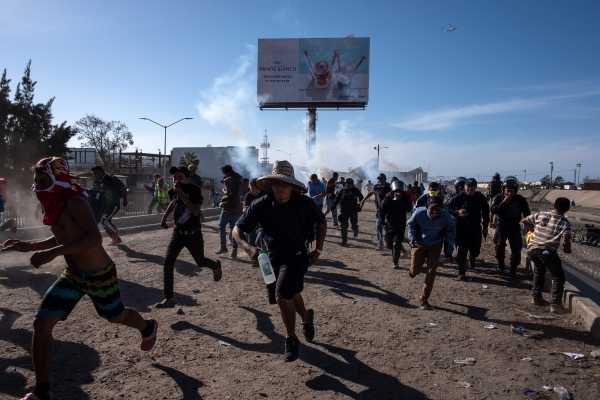
A planned peaceful march by the migrant “caravan” broke down on Sunday at the US-Mexico border in Tijuana, as groups of desperate people attempted to cross the border en masse — escalating into US Border Patrol agents firing tear gas that spread for nearly a kilometer through a crowd that included hundreds of asylum seekers, including children.
One or more people threw rocks at Border Patrol agents, who responded with tear gas and rubber bullets. The San Ysidro Port of Entry, the biggest official border crossing into the US, remained completely shut down in both directions during the unrest and for hours afterward.
The violence was the culmination of a situation that’s been deteriorating for over a week, after caravan members began to arrive in a city that’s already hosting thousands of asylum seekers waiting to cross legally into the US at San Ysidro. The stated purpose of Sunday’s march — for caravan members to be allowed to seek asylum in the US, or to meet with a representative of the US government — reflected the growing desperation and frustration of Tijuana’s waiting asylum seekers.
The unrest and tear gas aren’t simply the US government’s response to the arrival of the caravan. Nor were they directly related to a pending agreement between the US and the incoming Mexican government, reported Saturday, that would force asylum seekers to remain in Mexico while the US processes their claims.
The caravan’s weeks-long journey has come to an end just as pressure is rising, across the border. Trump’s border policy has squeezed asylum seekers at both ends: Officials stress that migrants ought to present themselves legally at ports of entry, while asylum seekers at ports are forced to wait days or weeks for entry to the US, and President Donald Trump himself says they shouldn’t be coming at all.
Trump has been portraying the US-Mexico border as in crisis since the spring, but the crisis (at least in Tijuana) has finally arrived. Each side of the US political debate perceives a different emergency: Trump and conservatives see an invasion of hostile, criminal forces, while his critics see an unprovoked attack on vulnerable families. But both views reflect the same underlying crisis: that so many asylum seekers, exhausted and desperate, are on the doorstep of the US, trying to reconcile their legal right to seek asylum with the reality that they’re not going to be allowed in “the right way” anytime soon.
What happened during Sunday’s march and port shutdown
- On Sunday, members of the migrant caravan (the first wave of which, numbering several thousand people, began to arrive in Tijuana last weekend) planned to hold a march to demand asylum in the US and protest the conditions in the migrant shelters where they’re staying. Caravan members sought to be allowed to enter the US or speak to a representative of the Trump administration to negotiate.
- In preparation for the march, Border Patrol deployed additional agents to the border around San Ysidro for crowd control. Active-duty military (who have been assisting border agents along the US/Mexico border since last month) don’t appear to have been involved in crowd control themselves, but did assist Border Patrol agents in moving barricades into place.
- Shortly after 11 am Pacific time, the march splintered as groups of people attempted to cross the border en masse. According to BuzzFeed News, hundreds of marchers got past Mexican federal police who were barricading the border from the Mexican side. (In the confrontation, one Mexican police officer suffered a minor injury: a split lip.)
- Around 11:15 am, US and Mexican authorities shut down the San Ysidro Port of Entry entirely, blocking both pedestrians and vehicles from crossing from Mexico into the US or vice versa.
- Shortly before noon, US officials fired tear gas and a “flash-bang” grenade at a group of people attempting to cross through a fence into the US. Video taken of the incident shows rocks being thrown at agents before the tear gas was fired. (Customs and Border Protection officials said Monday that four agents were hit with rocks over the course of the day.) Witnesses also reported that Border Patrol agents fired rubber bullets.
- Agents also fired tear gas at a group of people who were attempting to use a train crossing to enter the US. That group included families with small children, who attempted to hide under the train to avoid the gas.
- Wind carried the tear gas up to a kilometer away, an area that included hundreds of asylum seekers.
- In a separate incident an hour later, Border Patrol agents fired tear gas canisters to disperse a group of people attempting to cross the Tijuana Canal into the US.
- By mid-afternoon Pacific time, the asylum seekers had dispersed and retreated. The San Ysidro port opened to pedestrians around 3:45 pm, and was open to all traffic by 6.
- Mexican police report that 39 people were arrested for trying to cross forcibly into the US and will be prosecuted. While the US government reported that no one successfully crossed into the US, witnesses and Mexican police sources said that people were arrested by US Border Patrol agents after crossing.
- Customs and Border Protection officials told reporters Monday that all uses of force, including the firing of tear gas, will be reviewed under agency policy to judge whether they were appropriate or not.
Pressure on the San Ysidro port has been building for months
The chronology above makes it clear that what happened wasn’t a planned incursion by “the caravan” into the US — or even the first attempt by caravan members to seek asylum in the US. What happened is that people desperate for entry into the US took matters into their own hands — and US Border Patrol officials reacted with force.
But to understand how people who arrived in Tijuana barely a week ago are already so desperate, you have to understand that thousands of people were already waiting to seek asylum in the US before the caravan even began to arrive.
The San Ysidro port of entry is the most common place for Central Americans to seek asylum in the US, because it’s so large and because the route to Tijuana is safer than traveling through northeast Mexico into Texas. But for months, the number of asylum seekers going to San Ysidro has outstripped the number the US actually allows in to seek asylum.
Under a policy of “metering” asylum seekers, in which US officials limit the number of people who are allowed to enter the port and ask for asylum each day, migrants currently wait two months or longer in Tijuana before being allowed to enter the US.
Citing resource constraints, the US allows 60 to 100 asylum seekers — or fewer — into San Ysidro each day. An unofficial wait list of hundreds of people over the summer ballooned to thousands this fall. Before the caravan arrived, wait times stretched to two months, and the migrant shelters in Tijuana were already near capacity.
Many of the caravan members have been put up in a sports complex in Tijuana that’s been converted into a temporary shelter. Over the weekend, rains flooded the sports complex. The local government and nonprofits have struggled to feed everyone.
The mayor of Tijuana — possibly using the issue for his own benefit — has said repeatedly that he doesn’t have the money to support so many asylum seekers and has demanded that the national government give him more funds.
Many migrants in the caravan weren’t expecting the wait or the conditions. They’ve already been traveling for weeks, often with children in tow, with the hope of getting asylum in the US. In many cases, they’ve had the mistaken expectation that asylum would be granted immediately after they arrived. That hasn’t happened, and they’re getting desperate. And desperate people do desperate things.
Conservatives see Sunday’s march as an attack; liberals see Trump’s response as a war crime
Sunday’s events in Tijuana have alarmed both conservatives and liberals in America, for totally different reasons. Conservatives look at reports of migrants throwing rocks and conclude that the border truly is under attack, and that Trump has been right about the character of the caravan (“stone-cold criminals”) all along.
Liberals, meanwhile, have focused on images of families running away from tear gas and been horrified that the US government would act so cruelly toward people trying to seek asylum, which is legal under US law.
Tear gas is considered a chemical weapon under international law, making the US government’s response seem all the more hostile. But it also highlights the strangeness of the role that Border Patrol is playing right now: It’s a domestic law enforcement agency that’s working in concert with law enforcement in another country to prevent people from crossing a border.
Tear gas is illegal for international use, but not for use in domestic law enforcement. Local police departments in the US frequently use it to disperse crowds when someone in the crowd is engaging in illegal activity, especially when someone in the crowd is throwing things at law enforcement officials.
But this isn’t domestic law enforcement: The tear gas canisters clearly crossed an international border, and their aim, working in concert with Mexican officials, was to prevent people from being able to step onto US soil (at which point the US would be obligated to hear their asylum claims without turning them back under current law).
The fundamental problem is that both countries — the US and Mexico — are dealing with a large and increasingly desperate group of people. Many of those people are families and small children. Some of those people responded to desperation by attempting to cross into the US between ports of entry, which is a federal misdemeanor; a few reacted by throwing things at Border Patrol agents massing against them.
The US was successfully able to dispel the crowds Sunday. But there’s no indication that the situation in Tijuana — the waiting, the poor conditions, or the desperation — is going to get any better on its own soon.
Sourse: vox.com






